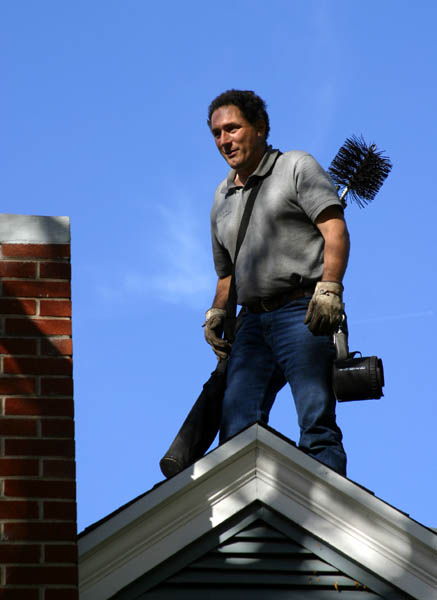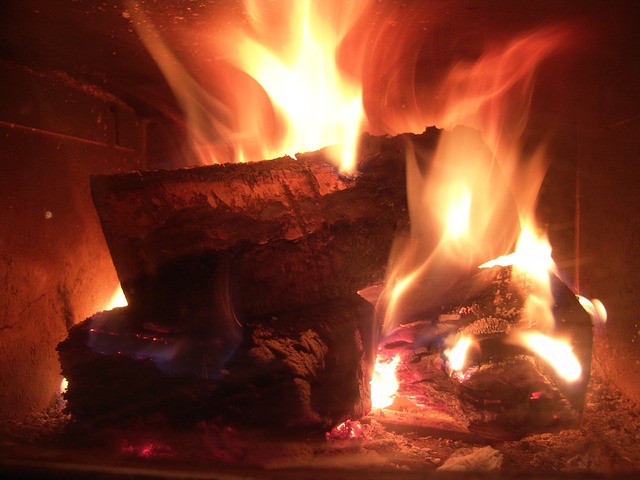Chimney Sweep

A chimney sweep will do a thorough chimney cleaning to remove any deposits, soot, creosote, and blockages from the chimney. Dirty, damaged deteriorating, and blocked chimneys cause injuries and fires every year. If you use you fireplace or wood burning stove, the National Fire Protection Association recommends having your chimney inspected and swept yearly in order to prevent fires.
What does a chimney sweep do?
A chimney service professional will do a complete cleaning of your chimney. Cleaning logs are really not effective and are not recommended. They will not get all the soot and creosote buildup out of the chimney like hand cleaning.
Step 1: Protecting
To begin, a cleaning technician will protect the inside of your home by spreading tarps over the room, floor, and hearth. They will cover the fireplace with vinyl sheeting, inserting an industrial vacuum hose into the fireplace, and will then tape and seal off the fireplace. They’ll attach extension hoses and run them to the industrial vacuum with a fine micron filter which sits outside. This will trap the fine soot, creosote, and other dirt later.
Step 2: Sweeping
Next, they will brush the entire chimney with hand held brushes, and brushes with extension rods. Generally they will begin at the top of the chimney and work downward, carefully brushing all the surfaces. Your chimney sweep will clean the flue, the damper, the smoke chamber, the smoke shelf, and the firebox.
Step 3: Clean Up
They will then peel back a small area of the vinyl sheeting and use a variety of brushes inside. Following this, everything will be vacuumed and cleaned. The vinyl sheeting and tarps will be moved outside, cleared off and put away.
Our expert chimney specialists offer a full range of services including sweeping. We provide fast and reliable service.
Call us today at (877) 959-3534 for chimney sweep service!

What exactly is creosote?
Creosote is a brown, oily, tar-like substance which forms from burning wood or coal. It begins as a loose, feathery build up which at first can be brushed away easily. As it accumulates more, it becomes tar-like, and is more difficult to remove, sometimes needing the use of scrapers to remove it. If left uncleaned, and more layers develop, the creosote hardens.
When a fire is burned in the fireplace or wood stove, the smoke becomes very hot. Hardened creosote can start to drip and melt like wax. Once the build up of creosote is very heavy, it restricts the airflow through the chimney flue. The restricted air flow causes creosote to build up even faster.
Is creosote dangerous?
Creosote is dangerous in a couple of different ways. It’s toxic and unsafe for your health, and it puts your home at risk of fires.
Carbon Monoxide
Creosote build up causes diminished airflow and this can allow carbon monoxide to build up inside your home while a fire is burning. Carbon monoxide is an odorless and colorless gas which can cause flu-like symptoms, and can even lead to death.
Creosote Toxicity
Besides the carbon monoxide build up, creosote itself is toxic. It could cause irritated skin and eyes, respiratory problems, and is carcinogenic (cancer causing).
Fire Hazard
The most dangerous thing about creosote is that it is incredibly flammable. It’s the most common cause of chimney fires. While chimneys are made to withstand a high level of heat, the intensity of a chimney fire can quickly exceed this level.
How to Get Rid of Creosote
Getting a chimney sweep performed is the best and most effective way to eliminate creosote. Our licensed chimney service companies take great care of your chimney and your home. We recommend that you get your chimney cleaned and inspected at least once a year in order to prevent fires and toxic build up.
Call us at (877) 959-3534 to request a chimney sweep quote!
How often should my chimney be cleaned?
How often a chimney should be cleaned depends of how often you use it and what materials you burn inside. Gas burning fireplaces should be inspected yearly. Although they burn cleaner, moisture, debris, cracks and other issues can develop which can allow carbon monoxide to get into the home.
Oil burning flues should be cleaned once a year to keep soot from building up.
Because wood burning fireplaces and stoves create more soot and creosote, they should be swept more frequently. A good rule of thumb is to have your chimney swept after a cord of wood has been burned inside.